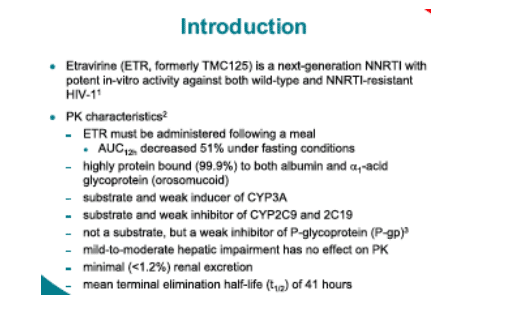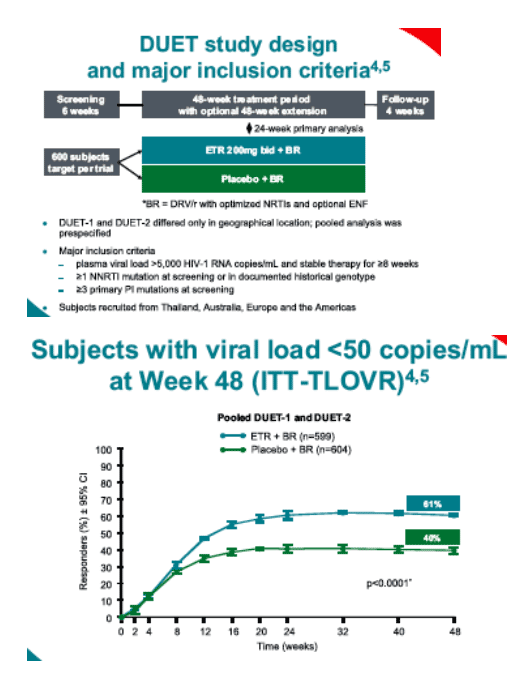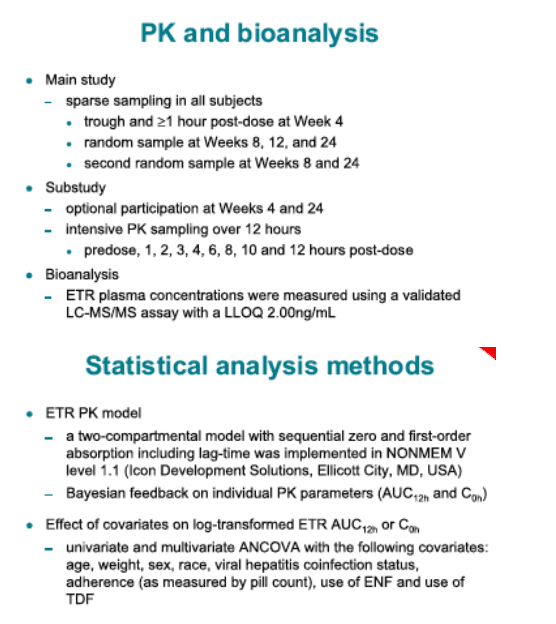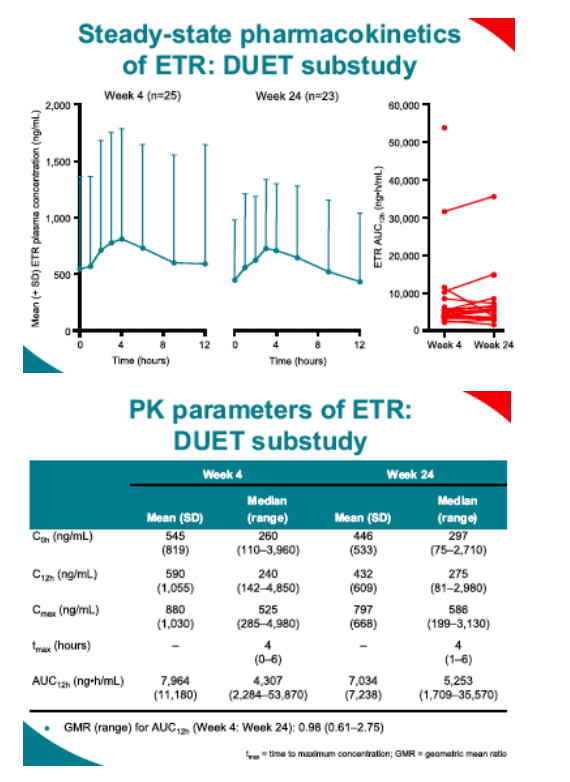 |
 |
 |
| |
Pharmacokinetics of etravirine (ETR; TMC125) are not affected by sex, age, race, use of enfuvirtide (ENF) or treatment duration in HIV-1-infected subjects; tenofovir and HCV affect levels
|
| |
| |
Reported by Jules Levin
9th International Workshop on Clinical Pharmacology of HIV Therapy
April 7-9, 2008
New Orleans
Thomas N Kakuda,1 Monika Scholler-Gyure,2 Monika Peeters,2 Chris Corbett,2 Goedele De Smedt,2 Brian J Woodfall,2 Richard MW Hoetelmans2
1Tibotec Inc., Yardley, PA, USA; 2Tibotec BVBA, Mechelen, Belgium
Discussion and conclusions
ETR has moderate-to-high inter and intrasubject variability
-- intersubject variability probably due to metabolism via multiple CYP isozymes (i.e. CYP3A, 2C9 and 2C19), adherence, concomitant medications (e.g. TDF) and/or hepatitis coinfection status
-- intrasubject variability probably due to CYP2C19,6,7 adherence, concomitant medications and/or food effects.
ETR pharmacokinetics do not vary by sex, age, race, use of ENF or treatment duration.
TDF decreases ETR AUC12h by about 26%
-- consistent with interaction studies in healthy volunteers
-- mechanism unknown
-- effect of TDF on CYP2C19?
Hepatitis coinfection increases ETR AUC12h about 1.35-fold
-- change in CL/F was negligible (+8.3%) in subjects with HBV, whereas a 24% decrease in CL/F was observed in subjects with HCV
-- no obvious difference in concomitant medications or baseline demographics
-- mechanism unknown.
ETR AUC12h was slightly higher with decreasing weight or increasing adherence.
No relationship between pharmacokinetics and efficacy or safety have been demonstrated in the DUET trials8
-- no dose adjustments are needed for TDF, hepatitis coinfection status or weight.
Abstract
Background
ETR is a recently US Food and Drug Administration-approved next-generation NNRTI. In vitro, ETR has potent activity against both wild-type and NNRTI resistant HIV. ETR 200mg bid was superior to placebo in the proportion of treatment-experienced HIV-1-infected subjects achieving viral load <50 copies/mL at Week 48 from two identical, ongoing Phase III, double-blind, randomized trials (DUET-1 and DUET-2 [TMC125-C206 and C216]).
Methods
Plasma concentrations of ETR over 12 hours were collected at Weeks 4 and 24 in a substudy of both DUET trials; pharmacokinetic (PK) parameters (area under the plasma concentration-time curve over 12 hours [AUC12h] and minimum and maximum plasma concentration [Cmin and Cmax, respectively]) were determined using noncompartmental analysis (WinNonlin Professional 4.1). A two-compartment model with sequential zero-order and first-order absorption including lag-time was developed for population pharmacokinetics analyses (NONMEM V level 1.1); AUC12h and predose plasma concentration (C0h) were individually estimated from sparse sampling collected over 48 weeks using Bayesian feedback in DUET subjects randomized to ETR.
The effect of sex, age, race, weight, adherence to ETR by pill count, use of
ENF or tenofovir (TDF) and hepatitis B and/or C coinfection on ETR AUC12h or C0h was assessed using analysis of covariance (ANCOVA) model. The effect of treatment duration was assessed graphically in the main study and by comparison of PK parameters in the substudy.
Results
Twenty-five subjects participated in the substudy at Week 4, and 23 subjects remained in the substudy at Week 24. The geometric mean ratio between Week 4 and 24 was 0.98 for AUC12h. DUET-1 and DUET-2 collectively enrolled 1,203 subjects of which 599 were randomized to ETR; population pharmacokinetics were estimated in 575 subjects.
Mean (standard deviation [SD]) ETR AUC12h and C0h was 5,506 (4,710) ng·h/mL and 393 (391) ng/mL, respectively. Inter and intrasubject variability was 60% and 40%, respectively.
Mean (SD) ETR AUC12h in 57 women was 6,027 (3,591) ng·h/mL compared to 5,449 (4,817) ng·h/mL in 518 men (p=0.20).
Mean (SD) ETR in Caucasians (n=360), Blacks (n=67), Hispanics (n=56) and Asians (n=7) was 5,552 (5,264), 5,451 (3,524), 5,183 (2,483) and 10,299 (7,185) ng·h/mL, respectively (p=0.23).
ETR exposure (AUC12h) increased with increasing adherence (p=0.0187) or decreasing weight (p=0.0490).
Use of ENF had no effect on ETR AUC12h (p=0.80), but as expected, TDF was associated with a 26% decrease in AUC12h (p=0.0005).
Hepatitis B and/or C coinfection was associated with a 1.35-fold increase in AUC12h (p=0.0028).
There was a trend for higher ETR exposure with higher age (p=0.0645). Visual inspection of plasma concentrations over 24 weeks revealed no treatment duration-dependent effects.
Conclusions
ETR pharmacokinetics do not vary by sex, race, age or use of ENF. TDF decreases ETR exposure, whereas hepatitis B and/or C coinfection was associated with higher ETR exposure. ETR exposures were slightly higher in subjects with lower weight and greater adherence. No dose adjustments for ETR are necessary for these covariates. There was no apparent treatment duration-dependent clearance in ETR pharmacokinetics




References
1. Vingerhoets J, et al. J Virol 2005;79:12773-82.
2. INTELENCE package insert.
3. Scholler-Gyure M, et al. IWCPHIV 2008. Poster P22.
4. Haubrich R, et al. CROI 2008. Poster 790.
5. Johnson M, et al. CROI 2008. Poster 791.
6. Yin OQP, et al. J Clin Pharmacol 2004;44:582-9.
7. Kim MJ, et al. Clin Pharmacol Ther 2002;72:192-9.
8. Kakuda TN, et al. CROI 2008. Poster 762.
|
| |
|
 |
 |
|
|